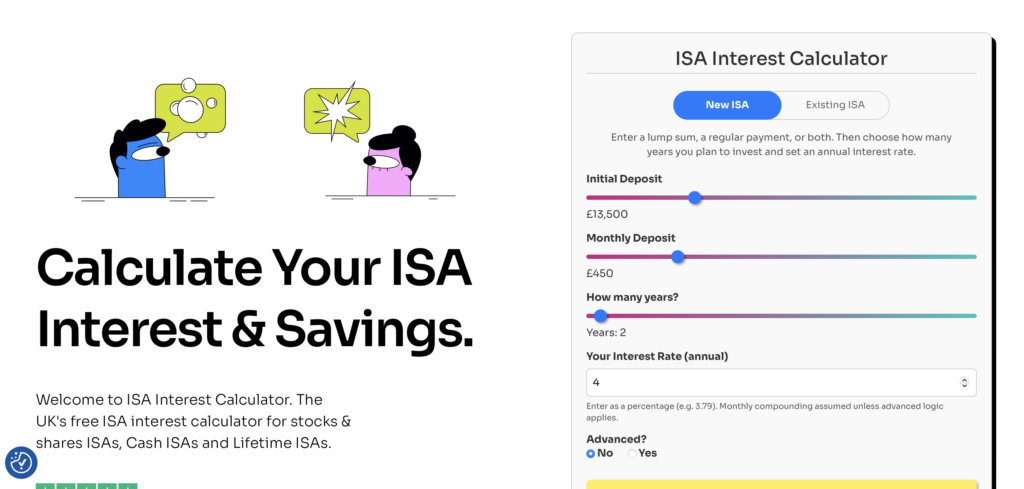
What do ISA Interest Calculators do?

An ISA interest calculator is essentially a tool that helps you estimate how your savings might grow over time under different scenarios. This includes:
- How much you deposit initially.
- How much you contribute each month or year.
- Whether you choose a fixed or variable rate.
- How often interest is paid and compounded.
- Potential changes in interest rates over the term.
At its core, an ISA interest calculator does the number-crunching for you, showing how small, regular contributions can stack up and how interest rate fluctuations or fixed terms might affect your final balance.
The gap between real returns and headline rates
You’ve probably seen some impressive “headline” rates advertised by banks. Sometimes these are short-term, boosted (or bonus) rates that only apply for the first few months, or even the first year. Afterwards, the rate can drop to something far less appealing.
The problem is that some standard calculators—often on bank websites—might emphasise that high temporary rate in their projections and don’t do a very good job of showing you the lower rate you’ll actually earn once the bonus ends. This can lead to unrealistic expectations about how much you’ll end up with.
That’s why using a more detailed ISA interest calculator, such as the one we offer on our site, can be incredibly helpful. It can account for:
- Introductory bonus rates that expire after a set period.
- Potential or predicted changes in the Bank of England base rate (especially relevant for variable-rate ISAs).
- The impact of compounding on both your principal and any new contributions.
By factoring in all these variables, you get a more realistic, warts-and-all picture of your future savings.
How calculators help you compare fixed vs variable rates

One of the biggest questions when choosing an ISA is whether to go for a fixed or variable rate. A good ISA interest calculator can help you assess each option side by side.
Fixed-rate ISAs
With a fixed-rate ISA, you know exactly what your interest rate will be for a specific term—often one, three, or five years. This makes calculations a bit simpler: if you’re getting 4.0% for three years, you just factor that in without worrying about fluctuation. However, if rates go up in the broader market, you won’t benefit unless you break your fixed-term agreement (which often comes with penalties).Variable-rate ISAs
Variable-rate ISAs can be trickier to calculate because they track the market or a bank’s internal rate, which can go up or down. A standard bank calculator might just show you today’s rate, but a more advanced tool, like ISA Interest Calculator, can let you input possible rate changes over the next few years. For instance, if you expect rates to drop by 0.5% each year until 2030, you can incorporate that assumption directly into your calculation and see how your final balance might compare to a fixed-rate scenario.
Real-world examples
Let’s imagine two scenarios in 2026, where the Bank of England base rate is around 4.0% but is predicted to decrease by 0.5% each year, possibly ending up near 2.0% by 2030.
fixed scenario
- You lock in at 4.0% for three years.
- You deposit £1,000 initially and contribute £100 each month.
- Over those three years, you’d earn 4.0% consistently.
- A calculator that accounts for compounding on monthly contributions would show how each deposit gains interest and how that interest gets added to your principal, earning even more interest.
- variable scenario
- You start at 4.0% in 2025, but each year the rate drops by 0.5%.
- You make the same deposit of £1,000 and keep contributing £100 monthly.
- A sophisticated calculator factors in the diminishing rate each year, adjusting the compounding amounts accordingly.
- By 2030, your overall returns might be lower than the fixed scenario if the rate indeed falls steadily. However, if it dips more slowly than expected, you might end up better off.
This is where an accurate and flexible calculator matters. Banks might show the 4.0% rate and not emphasise that it’s likely to drop year over year. You could get a misleading picture of how much you’ll actually earn if you assume that higher rate will hold for the entire term.
How monthly contributions can help
Let’s not forget the effect of monthly contributions. Adding even a small amount regularly can dramatically change your end balance, because each new contribution starts earning interest as soon as it’s deposited. Over years of consistent saving, these small additions can compound alongside your initial lump sum.
- Example: If you put £50 a month into your ISA, you might not notice a huge difference in your monthly budget. But after five or ten years, that steady trickle of money—plus any interest you earn each year—can become a surprisingly healthy nest egg.
A thorough ISA interest calculator will allow you to factor in monthly or yearly contributions. It should also let you choose whether you want to simulate compounding monthly, quarterly, or annually, as different providers have different compounding schedules.
The risk of relying on “teaser” calculators

Banks know people like to see big numbers, so they’ll often show a “best-case” scenario. This might include:
- The promotional rate for the full year, even though it’s only valid for a few months.
- An assumption that the Bank of England rate will stay the same, when predictions say it could shift.
- No option to add changing rates or multiple compounding intervals.
When you rely on these simplified or one-sided calculators, you might end up disappointed later. That’s why it’s wise to look for a more transparent tool, like ISA Interest Calculator, which allows you to add in the actual time frames for a boosted rate, as well as your own assumptions about how rates might evolve.
What to watch out for when comparing calculator results

Here are a few pointers to keep in mind when you’re reviewing results from different tools:
- assumed annual equivalent rate (AER): Does the calculator assume you’ll earn the same annual rate the whole time, or does it show you how variable rates might change each year?
- introductory bonuses: How long is the bonus rate valid, and at what rate will the ISA revert once that period ends?
- compounding frequency: Some accounts compound daily, others monthly, quarterly, or annually. It makes a difference in your end result, so choose the frequency your provider actually uses.
- fees or penalties: If it’s a fixed-rate ISA, do you get penalised for early withdrawals? Some calculators ignore these costs, which can give an overly rosy view of your savings.
What a ‘real’ ISA calculator can do
So what are the real benefits of a calculator that can handle all these nuances? First, it takes the guesswork out of your planning. You don’t have to do any complicated maths yourself; the calculator does it for you. Second, it provides a more realistic projection. Rather than promising a steady 4.0% until 2030, it can factor in that 0.5% drop each year (or whatever you think is likely), showing you a scenario that might be closer to the truth.
This level of detail helps you make better decisions, such as whether to lock in a fixed rate for a few years or remain flexible with a variable option. You’ll also see how changing your monthly contributions—upping them from £50 to £100, for instance—could affect your end balance.
When we recalculate
Interest rates can change, sometimes unexpectedly. If you’re using an ISA interest calculator like ours to plan your savings, it’s a good idea to pop back in and recalculate whenever something significant shifts, such as:
- The Bank of England changes its base rate.
- Your provider adjusts its variable interest rate.
- You’re nearing the end of your fixed-term ISA.
- You receive a pay rise and can afford to increase your monthly contributions.
Revisiting your assumptions every year or so can keep your plan on track. It also helps you stay informed about whether it’s time to switch ISA providers or change your approach.
Final thoughts
ISA interest calculators are invaluable for anyone who wants a clear picture of how their savings might grow over time. They help you cut through the shiny advertisements and overly optimistic predictions that some banks might put forward. By considering variable rate drops, introductory bonuses, monthly contributions, and compounding, you’re far more likely to land on a realistic figure and choose the most suitable ISA for your personal goals.
Ultimately, the best approach combines early and consistent saving (to let compounding do its work) with the right choice of ISA type for your situation. Whether you choose fixed or variable, an honest calculator—like the one at ISA Interest Calculator—helps you see the impact of each decision and compare scenarios head-to-head.
Don’t forget: your savings plan isn’t set in stone. If the environment changes or your needs shift, you can revise your calculations and possibly transfer your ISA to a better fit. In a financial landscape where interest rates can fluctuate by the year, that flexibility is incredibly valuable. By using a detailed ISA interest calculator and regularly reviewing your strategy, you can avoid nasty surprises and keep your savings on a steady growth path.
Resources for ISA interest calculators
As a UK saver & investor for over 10 years and avid ISA user; James decided to build ISA Interest Calculator to help everyday British savers with calculating potential ISA returns. Having worked for a large FTSE100 company building financial AI tools for over 5 years, he brought his expertise to personal finance and quickly launched several highly-respected and successful finance & investing sites for UK savers and investors.
- James Warwick
- James Warwick
- James Warwick
- James Warwick

2 Responses